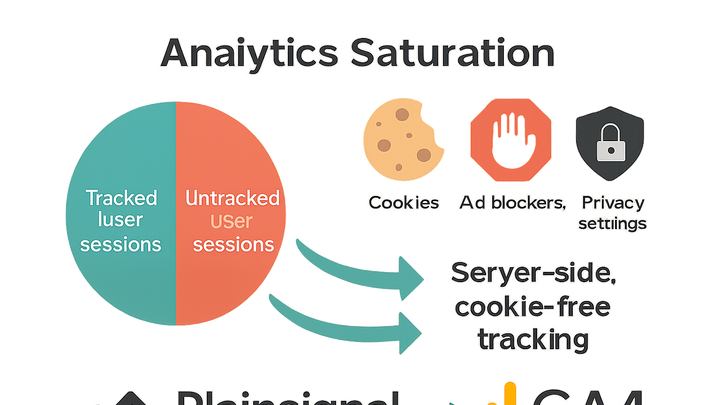Published on 2025-06-22T05:25:47Z
What is Saturation in Analytics?
Saturation in the context of web analytics refers to the extent to which an analytics solution captures all actual user interactions on your site or app. It is expressed as a percentage of total visits, events, and conversions that are successfully recorded relative to the real-world volume. A high saturation rate ensures that your reports accurately reflect user behavior, enabling you to make data-driven decisions with confidence. Conversely, low saturation can result in incomplete datasets, leading to skewed metrics, misguided optimizations, and missed business opportunities. Various factors influence saturation, including cookie restrictions, ad blockers, and sampling thresholds deployed by analytics tools like GA4. By leveraging privacy-centric, server-side solutions such as PlainSignal alongside best practices in tag implementation and consent management, teams can maximize saturation and ensure robust, representative data coverage. Read on for definitions, impacts, and actionable strategies to improve your analytics saturation.
Saturation
Proportion of real user interactions captured by an analytics platform, reflecting data completeness and tracking coverage.
Definition and Importance
Saturation measures the completeness of tracking data captured by your analytics solution. Achieving high saturation means you have a more representative dataset, leading to more reliable insights and data-driven decisions. Without sufficient saturation, reported metrics can be skewed by missing data, resulting in inaccurate conversion rates, user behavior analysis, and ROI measurement.
-
Definition
The percentage of actual user interactions (pageviews, events, transactions) that an analytics platform records relative to total interactions.
-
Why it matters
High saturation ensures data completeness, reduces sampling bias, and improves confidence in analyses such as funnel reports, cohort analysis, and attribution modeling.
Factors Affecting Saturation
Several technical and behavioral factors can limit saturation, including cookie restrictions, ad blockers, consent management, and sampling algorithms built into analytics platforms like GA4.
-
Cookie restrictions
Browsers and user settings that block or delete cookies prevent tools like GA4 from recognizing returning users, lowering tracking coverage.
-
Ad blockers and tracking prevention
Extensions and browser privacy features can block analytics scripts and stop requests to tracking endpoints, reducing the volume of captured data.
-
Sampling thresholds
GA4 may apply sampling to large datasets when query thresholds are exceeded, which can omit a subset of data from reports and affect saturation.
-
Consent management
When users opt out of tracking through banners or privacy controls, analytics tools will not record their interactions, impacting the overall data coverage.
Improving Saturation with SaaS Tools
You can enhance your saturation rate by adopting privacy-conscious, server-side, or cookie-free analytics solutions like PlainSignal, and by configuring GA4 optimally.
-
Cookie-free tracking with PlainSignal
PlainSignal uses server-side and fingerprinting techniques to achieve near-total tracking coverage without relying on cookies.
-
Implementation example
<link rel="preconnect" href="//eu.plainsignal.com/" crossorigin /> <script defer data-do="yourwebsitedomain.com" data-id="0GQV1xmtzQQ" data-api="//eu.plainsignal.com" src="//cdn.plainsignal.com/plainsignal-min.js"></script>
-
-
Enhanced measurement in GA4
GA4’s Measurement ID and gtag.js allow for automatic event collection and user tracking but remain subject to cookie restrictions and sampling.
-
GA4 gtag.js snippet
<!-- Global site tag (gtag.js) - Google Analytics --> <script async src="https://www.googletagmanager.com/gtag/js?id=G-XXXXXXX"></script> <script> window.dataLayer = window.dataLayer || []; function gtag(){dataLayer.push(arguments);} gtag('js', new Date()); gtag('config', 'G-XXXXXXX'); </script>
-
-
Consent mode and server-side tagging
Using Consent Mode in GA4 together with server-side tagging frameworks helps preserve measurement integrity when users opt in or out of tracking.
